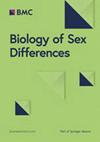对血浆细胞外囊泡脂质网络的新认识揭示了酒精使用障碍患者脂质组学特征的性别差异
IF 4.9
2区 医学
Q1 ENDOCRINOLOGY & METABOLISM
引用次数: 0
摘要
酒精使用障碍(AUD)是最常见的精神疾病之一,饮酒被认为是全球可预防死亡的主要原因。脂质在细胞膜中发挥着重要的功能作用;然而,我们对细胞外囊泡 (EV) 中脂质作为调节分子和疾病生物标志物的作用知之甚少。我们采用了一种敏感的脂质组学策略来表征 AUD 患者血浆 EVs 中的脂质种类,以评估其功能作用和酶活性网络,从而增进对饮酒后脂质代谢的了解。我们分析了AUD女性、男性和健康人的血浆EV脂质,突出显示了丰度不同的脂质,并利用LINEX2对脂质组学数据进行了生物学解释。我们的研究结果首次表明,AUD 女性在溶血磷脂酰胆碱/磷脂酰胆碱脂质和磷脂酶/酰基转移酶活性方面表现出更显著的底物-产物变化,而这些变化可能与癌症进展和神经炎症有关。相反,澳大拉西亚男性患有神经酰胺和鞘磷脂脂质失调,涉及鞘磷脂酶、鞘磷脂磷酸二酯酶和鞘磷脂合成酶活性,这与肝毒性有关。值得注意的是,对 AUD 女性和男性血浆 EVs 的分析表明,分别与 "负固有曲率 "和 "正固有曲率 "相关的脂质本体术语得到了丰富。我们的研究方法有助于加深对脂质代谢和调控机制的理解,从而有助于鉴定新的脂质靶标和发现 AUD 的性别特异性临床生物标志物。酒精使用障碍(AUD)是最常见的精神疾病之一,饮酒被认为是全球可预防死亡的主要原因。脂质在细胞膜中发挥着重要的功能作用;然而,我们对细胞外囊泡 (EVs) 中脂质作为调节分子和疾病生物标志物的作用知之甚少。我们采用了一种敏感的脂质组学策略来表征 AUD 患者血浆 EVs 中的脂质种类,以评估其功能作用和酶活性网络,从而增进对饮酒后脂质代谢的了解。我们分析了AUD女性、男性和健康人的血浆EV脂质,突出显示了丰度不同的脂质,并利用LINEX2对脂质组学数据进行了生物学解释。我们的研究结果首次表明,AUD 女性在溶血磷脂酰胆碱/磷脂酰胆碱脂质和磷脂酶/酰基转移酶活性方面表现出更显著的底物-产物变化,而这些变化可能与癌症进展和神经炎症有关。相反,澳大拉西亚男性患有神经酰胺和鞘磷脂脂质失调,涉及鞘磷脂酶、鞘磷脂磷酸二酯酶和鞘磷脂合成酶活性,这与肝毒性有关。值得注意的是,对 AUD 女性和男性血浆 EVs 的分析表明,分别与 "负固有曲率 "和 "正固有曲率 "相关的脂质本体术语得到了丰富。我们的研究方法有助于加深对脂质代谢和调控机制的理解,从而有助于鉴定新的脂质靶标和发现 AUD 的性别特异性临床生物标志物。本文章由计算机程序翻译,如有差异,请以英文原文为准。
Novel insight into the lipid network of plasma extracellular vesicles reveal sex-based differences in the lipidomic profile of alcohol use disorder patients
Alcohol use disorder (AUD) is one of the most common psychiatric disorders, with the consumption of alcohol considered a leading cause of preventable deaths worldwide. Lipids play a crucial functional role in cell membranes; however, we know little about the role of lipids in extracellular vesicles (EVs) as regulatory molecules and disease biomarkers. We employed a sensitive lipidomic strategy to characterize lipid species from the plasma EVs of AUD patients to evaluate functional roles and enzymatic activity networks to improve the knowledge of lipid metabolism after alcohol consumption. We analyzed plasma EV lipids from AUD females and males and healthy individuals to highlight lipids with differential abundance and biologically interpreted lipidomics data using LINEX2, which evaluates enzymatic dysregulation using an enrichment algorithm. Our results show, for the first time, that AUD females exhibited more significant substrate-product changes in lysophosphatidylcholine/phosphatidylcholine lipids and phospholipase/acyltransferase activity, which are potentially linked to cancer progression and neuroinflammation. Conversely, AUD males suffer from dysregulated ceramide and sphingomyelin lipids involving sphingomyelinase, sphingomyelin phosphodiesterase, and sphingomyelin synthase activity, which relates to hepatotoxicity. Notably, the analysis of plasma EVs from AUD females and males demonstrates enrichment of lipid ontology terms associated with “negative intrinsic curvature” and “positive intrinsic curvature”, respectively. Our methodological developments support an improved understanding of lipid metabolism and regulatory mechanisms, which contribute to the identification of novel lipid targets and the discovery of sex-specific clinical biomarkers in AUD. Alcohol use disorder (AUD) is one of the most common psychiatric disorders, with the consumption of alcohol considered a leading cause of preventable deaths worldwide. Lipids play a crucial functional role in cell membranes; however, we know little about the role of lipids in extracellular vesicles (EVs) as regulatory molecules and disease biomarkers. We employed a sensitive lipidomic strategy to characterize lipid species from the plasma EVs of AUD patients to evaluate functional roles and enzymatic activity networks to improve the knowledge of lipid metabolism after alcohol consumption. We analyzed plasma EV lipids from AUD females and males and healthy individuals to highlight lipids with differential abundance and biologically interpreted lipidomics data using LINEX2, which evaluates enzymatic dysregulation using an enrichment algorithm. Our results show, for the first time, that AUD females exhibited more significant substrate-product changes in lysophosphatidylcholine/phosphatidylcholine lipids and phospholipase/acyltransferase activity, which are potentially linked to cancer progression and neuroinflammation. Conversely, AUD males suffer from dysregulated ceramide and sphingomyelin lipids involving sphingomyelinase, sphingomyelin phosphodiesterase, and sphingomyelin synthase activity, which relates to hepatotoxicity. Notably, the analysis of plasma EVs from AUD females and males demonstrates enrichment of lipid ontology terms associated with “negative intrinsic curvature” and “positive intrinsic curvature”, respectively. Our methodological developments support an improved understanding of lipid metabolism and regulatory mechanisms, which contribute to the identification of novel lipid targets and the discovery of sex-specific clinical biomarkers in AUD.
求助全文
通过发布文献求助,成功后即可免费获取论文全文。
去求助
来源期刊

Biology of Sex Differences
ENDOCRINOLOGY & METABOLISM-GENETICS & HEREDITY
CiteScore
12.10
自引率
1.30%
发文量
69
审稿时长
14 weeks
期刊介绍:
Biology of Sex Differences is a unique scientific journal focusing on sex differences in physiology, behavior, and disease from molecular to phenotypic levels, incorporating both basic and clinical research. The journal aims to enhance understanding of basic principles and facilitate the development of therapeutic and diagnostic tools specific to sex differences. As an open-access journal, it is the official publication of the Organization for the Study of Sex Differences and co-published by the Society for Women's Health Research.
Topical areas include, but are not limited to sex differences in: genomics; the microbiome; epigenetics; molecular and cell biology; tissue biology; physiology; interaction of tissue systems, in any system including adipose, behavioral, cardiovascular, immune, muscular, neural, renal, and skeletal; clinical studies bearing on sex differences in disease or response to therapy.
 求助内容:
求助内容: 应助结果提醒方式:
应助结果提醒方式:


